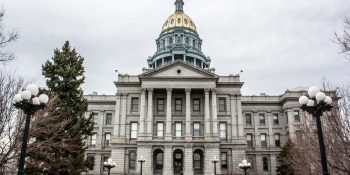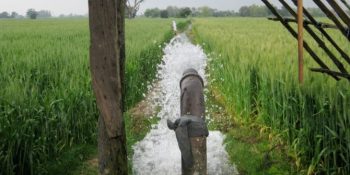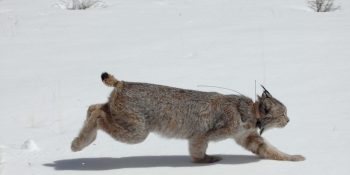U.S. national parks are full of natural sounds. In Rocky Mountain National Park, visitors might hear the bugle of elks. At Yellowstone National Park, wolves howl in the distance. Iconic sounds like these are often associated with specific parks, creating unique soundscapes and enriching visitor experiences.
However, when you add human-made noise, these natural sounds are at risk.
“Anthropogenic” noise – sound caused by human activity – has the unintended impact of masking natural sounds important to both visitors and wildlife. Noise is increasingly prevalent in natural spaces. Not only does this take away from visitors’ experiences, but it also has significant ecological consequences. Many animals’ survival depends on listening for approaching predators, and successful breeding for some species hinges on listening for the song of a potential mate.
With these ecological consequences in mind, a team of scientists from Colorado State University and the U.S. National Park Service (NPS) characterized the predominant human noise sources in 66 U.S. national parks in an effort to help parks better manage the noise problem. The study, “Anthropogenic noise in U.S. national parks – sources and spatial extent,” was published Oct. 2 in the Ecological Society of America’s journal Frontiers in Ecology and the Environment.
Human-made noise loud but localized in large parks
The researchers found that national park lands are largely bastions of natural sounds. While the team found anthropogenic noise causes a 10-fold or greater increase in natural background sound levels in over a third of parks in the study, the acreage impacted by such levels represents less than two percent of the total NPS lands.
The team found that even though trains and recreational watercraft are by far the loudest sources of noise, the greatest noise-causing culprits are vehicles and aircraft.
National Park Service lands quietest U.S. areas
Rachel Buxton, lead author of the study, said the team was encouraged by how quiet, for the most part, national parks areas are. Wilderness areas and natural resource parks were found to have fewer noise events and are quieter than other park types across North America, such as cultural parks or recreation areas.
While NPS lands remain among the quietest protected areas in the U.S., noise made by people or machines is increasingly common and is heard in 37% of recordings collected from NPS lands across the country.
“When we visit a park to experience nature, hearing cars and planes can be annoying,” said Buxton, who conducted the research as a postdoctoral fellow in the Department of Fish, Wildlife and Conservation Biology in CSU’s Warner College of Natural Resources. “What many people don’t realize is that these noises disrupt the calming effect of being in nature, with significant effects on our wellbeing and the wellbeing of wildlife.”
She is now a postdoctoral fellow at Carleton University in Ontario.
Analysis of nearly 47,000 hours of audio clips
The study relied on unprecedented audio data collection and analysis, the result of over a decade of collaboration between CSU and the NPS. Dozens of CSU students, trained to identify and measure different types of sounds, processed 46,789 hours of audio clips from 251 sites in 66 parks.
The research team then identified how frequent noise events were, what type of noise is most commonly heard, and their respective noise levels, or the loudness of the noises. The sounds were compared with measured noise levels across the continent, giving a more complete picture of where noise was highest and the most common sources.
Scientists found that it is more than just our vehicles making noise; another common source is simply human voices. In the context of visitor conversation, and speaking with and learning from park rangers, voices are intrinsic to park values and visitor experience. Yet, even when appropriate to the setting, these sounds affect wildlife. The designation of “quiet zones” can markedly improve noise levels, as successfully demonstrated in Muir Woods National Monument’s Cathedral Grove.
Insights on better managing noise for park service leaders, staff
The U.S. National Park Service was established over a century ago to conserve natural and cultural resources for future generations, which includes the iconic sounds found in nature.
“The Grand Canyon is grand because of its striking vistas, but also because of the sound of the river flowing through the canyon, wind rustling the leaves, and birds singing,” Buxton said. “Managing noise is essential for protecting our experiences in national parks, which are the country’s treasures.”
To fulfill this mission, NPS actively pursues innovations that will improve park sound environments and will showcase and improve sensory environments for people and ecosystems.
Researchers said the study findings can help parks understand the range of options available for managing noise from the most frequent noise culprits: cars and planes. To mitigate vehicle noise, parks can incorporate shuttle systems, establish speed limits, allow for electric vehicles, and use quiet pavement materials on roads. Aircraft noise, which can be heard from great distances at quiet sites, can be reduced by routing or scheduling flights to avoid sensitive areas.
“Numerous noise mitigation strategies have been successfully developed and implemented, so we already have the knowledge needed to address many of these issues,” said George Wittemyer, an associate professor at CSU and senior author of the study. “Our work provides information to facilitate such efforts in respect to protected areas where natural sounds are integral.”
The researchers said they are hopeful that as more noise research becomes public, people will consider sound as a valuable component of the natural environment, one that is currently at risk of being overwhelmed. “Protecting these important natural acoustic resources as development and land conversion progresses is critical if we want to preserve the character of parks,” Buxton added.
SPREAD THE NEWS
COMMENT, Like, Follow & SHARE @I70Scout





